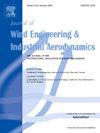A multi-sensor interval fusion adaptive regularization data assimilation model for wind direction prediction
IF 4.2
2区 工程技术
Q1 ENGINEERING, CIVIL
Journal of Wind Engineering and Industrial Aerodynamics
Pub Date : 2025-02-01
DOI:10.1016/j.jweia.2024.105996
引用次数: 0
Abstract
Real-time forecasting of wind fields is an essential prerequisite for computational fluid predictions of pollutant transport. In the domain of data assimilation for real-time weather forecasting, obtaining high-quality meteorological data measurements poses a challenge that significantly impacts prediction accuracy. Predicting wind direction through data assimilation presents an inverse problem, and low-quality wind direction data resulting from suboptimal sensor placement can lead to ill-posedness when constructing proxy models. Consequently, previous research has extensively investigated the optimal placement of meteorological sensors. However, the data assimilation experiment has thus introduced uncertainties associated with the positions of the sensors. To achieve this goal, this study proposes a adaptive data assimilation model. This model introduces the concept of local convergence intervals on reduced-order response model, and deconstructs ill-posed intervals into well-posed intervals, and obtains a unique solution interval by regularization through the convergence range distance fusing. Finally, the model selects sensors using adaptive local weights, and implements the data assimilation process using inverse Ensemble Kalman Filter. This paper employs data from the Huailai Test Station to design simulated wind direction experiments.The results indicate that the method is capable of overcoming the shortcomings of sensor placement and can enhance the accuracy of prediction.
一种用于风向预报的多传感器间隔融合自适应正则化数据同化模型
风场的实时预报是污染物输运计算流体预测的必要前提。在实时天气预报数据同化领域,获取高质量的气象数据测量值是影响预报精度的一大挑战。通过数据同化来预测风向存在一个逆向问题,并且由于传感器位置不佳导致的低质量风向数据可能导致在构建代理模型时的不适定性。因此,以往的研究广泛地探讨了气象传感器的最佳放置。然而,数据同化实验因此引入了与传感器位置相关的不确定性。为了实现这一目标,本研究提出了一种自适应数据同化模型。该模型在降阶响应模型上引入局部收敛区间的概念,将病态区间分解为良定区间,并通过收敛范围距离融合正则化得到唯一解区间。最后,利用自适应局部权重选择传感器,并利用逆集成卡尔曼滤波实现数据同化。本文利用怀来试验站的数据设计模拟风向试验。结果表明,该方法能够克服传感器放置的缺点,提高预测精度。
本文章由计算机程序翻译,如有差异,请以英文原文为准。
求助全文
约1分钟内获得全文
求助全文
来源期刊
CiteScore
8.90
自引率
22.90%
发文量
306
审稿时长
4.4 months
期刊介绍:
The objective of the journal is to provide a means for the publication and interchange of information, on an international basis, on all those aspects of wind engineering that are included in the activities of the International Association for Wind Engineering http://www.iawe.org/. These are: social and economic impact of wind effects; wind characteristics and structure, local wind environments, wind loads and structural response, diffusion, pollutant dispersion and matter transport, wind effects on building heat loss and ventilation, wind effects on transport systems, aerodynamic aspects of wind energy generation, and codification of wind effects.
Papers on these subjects describing full-scale measurements, wind-tunnel simulation studies, computational or theoretical methods are published, as well as papers dealing with the development of techniques and apparatus for wind engineering experiments.

 求助内容:
求助内容: 应助结果提醒方式:
应助结果提醒方式:


